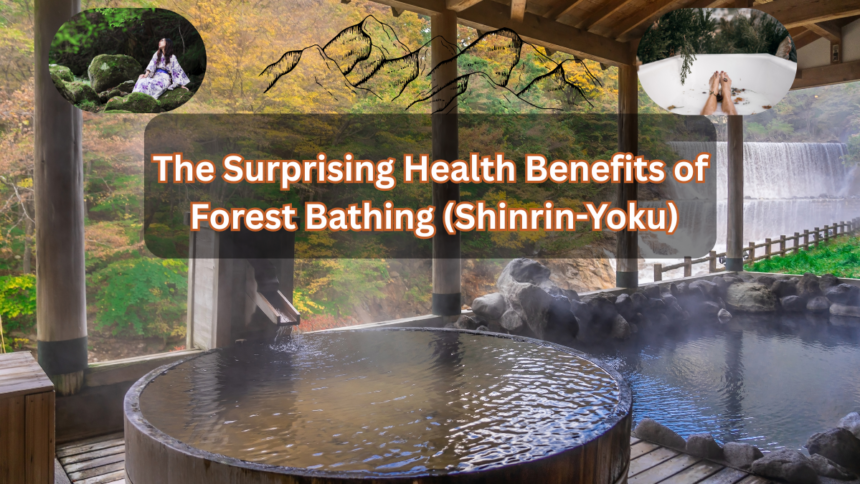Forest Bathing (Shinrin-Yoku)
Have you ever felt an instant sense of calm when stepping into a forest? The rustling leaves, the earthy scent, the soft sunlight filtering through the trees—it’s as if nature wraps you in a soothing embrace. This isn’t just a poetic feeling; it’s science. The Japanese practice of Shinrin-Yoku, or forest bathing, has been proven to offer remarkable health benefits, from reducing stress to boosting immunity.
In our fast-paced, screen-dominated lives, reconnecting with nature isn’t just a luxury—it’s a necessity. In this post, we’ll explore the science-backed benefits of forest bathing, how to practice it effectively, and why this ancient tradition is more relevant than ever.
What Is Forest Bathing (Shinrin-Yoku)?
Forest bathing isn’t about hiking, jogging, or even meditation—it’s simply about being in nature. Developed in Japan in the 1980s, Shinrin-Yoku translates to “taking in the forest atmosphere.” It’s a mindful, slow immersion in the woods, engaging all five senses to absorb the healing properties of nature.
Unlike a nature walk with a fitness goal, forest bathing encourages you to slow down, observe, and breathe deeply. Research shows that this practice can lower cortisol levels, improve mood, and even enhance immune function.
The Science-Backed Benefits of Forest Bathing
1. Reduces Stress and Anxiety
One of the most well-documented benefits of forest bathing is its ability to lower stress hormones. Studies have found that spending time among trees decreases cortisol levels, the body’s primary stress hormone. The phytoncides (natural oils released by trees) have a calming effect on the nervous system, reducing anxiety and promoting relaxation.
2. Boosts Immune Function
Believe it or not, forest air can strengthen your immune system. Phytoncides, like those found in cedar and pine trees, increase the activity of natural killer (NK) cells, which help fight infections and even cancer. A study by Japan’s Nippon Medical School found that a weekend forest trip led to a 50% increase in NK cell activity that lasted for weeks.
Video Credits
3. Improves Mood and Mental Clarity
Nature has a profound impact on mental health. Research published in Environmental Health and Preventive Medicine found that forest bathing significantly reduces symptoms of depression and anger. The combination of fresh air, natural scenery, and the absence of urban noise helps clear mental fog and enhances creativity.
4. Lowers Blood Pressure and Heart Rate
The tranquility of a forest naturally slows your heart rate and reduces blood pressure. A study in Hypertension Research showed that participants who practiced Shinrin-Yoku had lower blood pressure compared to those walking in an urban environment.
5. Enhances Sleep Quality
Exposure to natural light and fresh air helps regulate circadian rhythms. The reduction in stress hormones also contributes to deeper, more restful sleep. If you struggle with insomnia, a regular forest bathing routine might be the natural remedy you need.
How to Practice Forest Bathing: Simple Tips
You don’t need a dense jungle or a remote mountain—any green space with trees will do. Here’s how to make the most of your forest bathing experience:
1. Leave Distractions Behind
Put your phone on airplane mode. The goal is to be present, not to document the experience.
2. Engage All Five Senses
- Touch: Feel the bark of a tree or the texture of leaves.
- Sight: Observe the play of light and shadows.
- Sound: Listen to birdsong, rustling leaves, or a nearby stream.
- Smell: Breathe in the earthy scents of moss and pine.
- Taste: If safe, try wild berries or sip herbal tea made from forest plants.
3. Walk Slowly and Mindfully
There’s no destination—just wander without rushing. Stop often to take in your surroundings.
4. Breathe Deeply
Inhale the phytoncides deeply. Try diaphragmatic breathing to maximize relaxation.
5. Try “Tree Hugging” (Seriously!)
Studies suggest that physical contact with trees may enhance the calming effects of phytoncides.
6. Make It a Regular Habit
Even 20-30 minutes a few times a week can yield benefits.
Common Questions About Forest Bathing
Do I need a forest to practice Shinrin-Yoku?
No! A local park, botanical garden, or even a tree-lined street can work. The key is being around greenery.
Can children benefit from forest bathing?
Absolutely! Kids, especially those with ADHD, show improved focus and reduced hyperactivity after time in nature.
What if I live in a city?
Indoor plants, nature sounds, or even virtual forest walks (though less effective) can provide some benefits.
Final Thoughts
Forest bathing isn’t just a trend—it’s a return to our roots (pun intended). In a world where stress, burnout, and digital overload are rampant, Shinrin-Yoku offers a free, accessible, and powerful way to heal.
So, the next time you feel overwhelmed, step outside. Let the trees work their magic. Your mind, body, and soul will thank you.
Ready to try forest bathing? Share your experiences in the comments below—we’d love to hear how nature has helped you!


